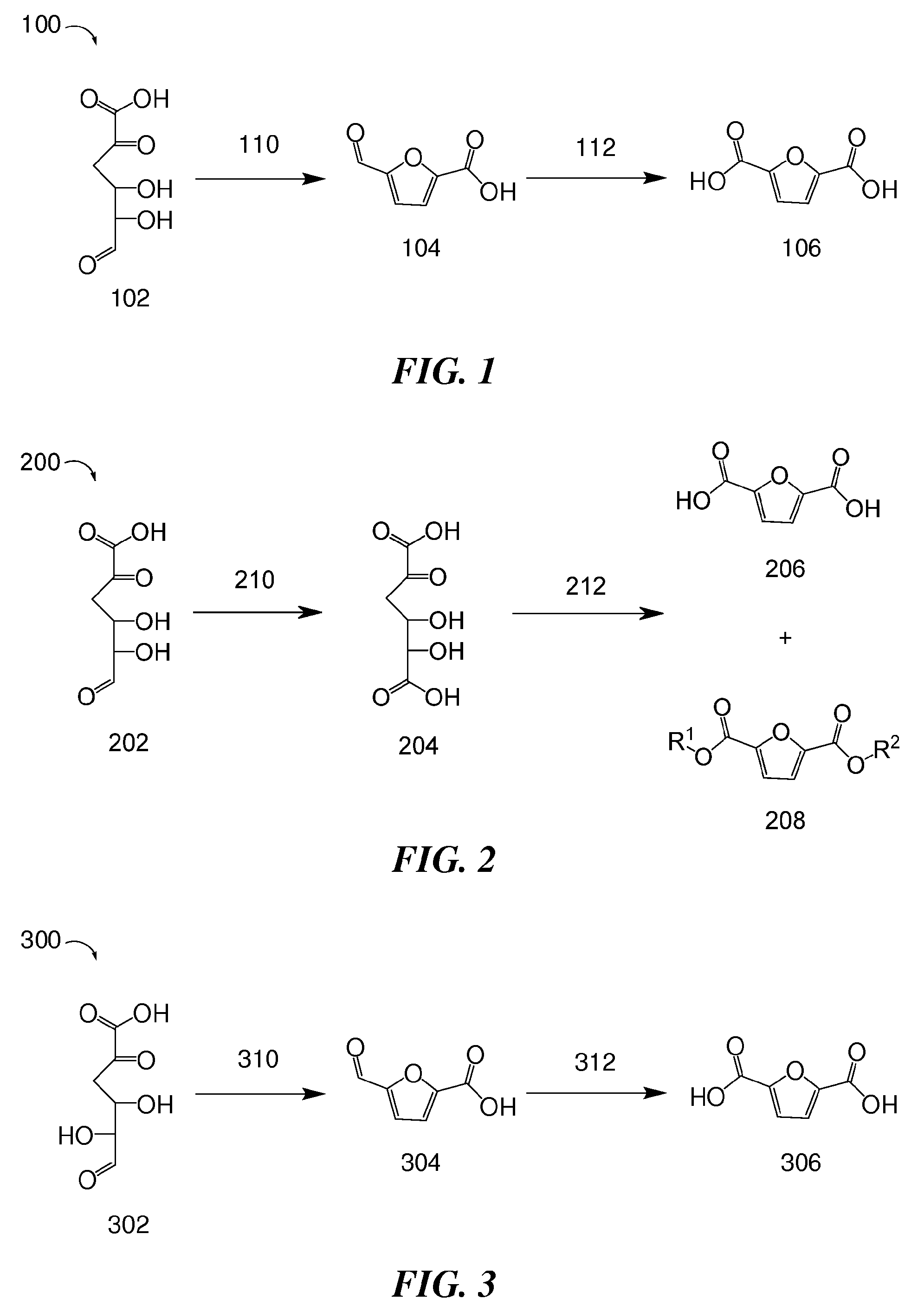Methods for preparing 2,5-furandicarboxylic acid
a technology of furandicarboxylic acid and fdca, which is applied in the field of methods for preparing 2, 5furandicarboxylic acid, can solve the problems of general selectiveness, and low yield of fdca from hexose derivatives, and achieve the effect of facilitating oxidation
- Summary
- Abstract
- Description
- Claims
- Application Information
AI Technical Summary
Problems solved by technology
Method used
Image
Examples
example 1
Conversion of DEHU into FFA
[0192]This example demonstrates the acid-catalyzed dehydration and cyclization of DEHU to yield FFA based on three different sulfuric acid treatments (0.2M, 10.7M, and 16 M sulfuric acid).
Materials and Methods
[0193]DEHU was first obtained by enzymatic degradation of alginate. Sodium alginate was combined with sterilized water. Sigma alginate lyase and oligoalginate lyase cleared lysate (from LB culture pellet) was then added to the sodium alginate solution. This reaction proceeded for about 18-24 hours, and DEHU was isolated. The DEHU obtained from this enzymatic degradation of alginate was used in the following reactions.
[0194]The starting materials in this example include glucose and DEHU. The concentrations of starting materials used in each of the reactions described in this example are summarized in Table 1 below. For the reactions with the lower starting material concentration, 0.125 mL of water was added to the reaction mixture.
[0195]
TABLE 1Summary ...
example 2
Conversion of DOHA and DEHU into FFA
[0203]This example demonstrates the acid-catalyzed dehydration and cyclization of DOHA and DEHU to yield FDCA and FFA in the presence of sulfuric acid and sodium tetraborate decahydrate, respectively.
Materials and Methods
[0204]The starting materials in this example include DOHA, galacturonate, and DEHU. The DEHU was first obtained by enzymatic degradation of alginate according to the procedure described in Example 1 above. The DOHA was obtained by oxidizing a solution of the DEHU obtained by enzymatic degradation of alginate according to the procedure described in Example 1 above.
[0205]The concentrations of starting materials used in each of the reactions described in this example are summarized in Table 2 below. For the reactions with the lower starting material concentration, 500 uL of water was added to the reaction mixture.
[0206]
TABLE 2Summary of the concentration starting materials, and products (FFA and 2-furancarboxylic acid)Starting materi...
example 3
Conversion of DEHU and DOHA into FFA and FDCA
[0211]This example demonstrates the acid-catalyzed dehydration and cyclization of DEHU and DOHA to yield FFA and FDCA in the presence of five different sulfuric acid treatments and sodium tetraborate decahydrate, respectively.
Materials and Methods
[0212]The starting materials in this example include galacturonate, DEHU, and DOHA. DEHU and DOHA were obtained according to the procedure described in Examples 1 and 2 above.
[0213]The concentrations of starting materials used in each of the reactions described in this example are summarized in Table 3 below.
[0214]
TABLE 3Summary of the concentration starting materials, and products (FFA and 2-furancarboxylic acid)Starting materialconcentration2-furancarboxylicAcid treatmentStarting material(mM)FFA (mM)acid (mM) 16M H2SO4galacturonate0.320.1190 16M H2SO4DEHU0.370.0660.066 16M H2SO4DOIIA0.380.1160.05114.4M H2SO4galacturonate0.310.054014.4M H2SO4DEHU0.370.0440.06114.4M H2SO4DOHA0.370.0510.04310.7...
PUM
| Property | Measurement | Unit |
|---|---|---|
| temperature | aaaaa | aaaaa |
| temperature | aaaaa | aaaaa |
| time | aaaaa | aaaaa |
Abstract
Description
Claims
Application Information
 Login to View More
Login to View More - R&D
- Intellectual Property
- Life Sciences
- Materials
- Tech Scout
- Unparalleled Data Quality
- Higher Quality Content
- 60% Fewer Hallucinations
Browse by: Latest US Patents, China's latest patents, Technical Efficacy Thesaurus, Application Domain, Technology Topic, Popular Technical Reports.
© 2025 PatSnap. All rights reserved.Legal|Privacy policy|Modern Slavery Act Transparency Statement|Sitemap|About US| Contact US: help@patsnap.com



